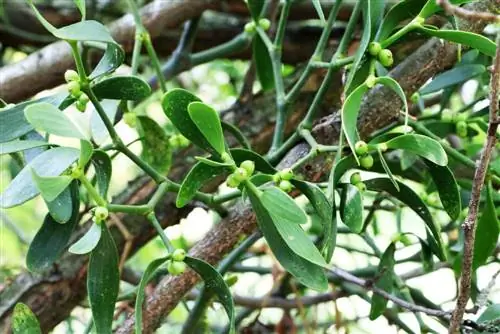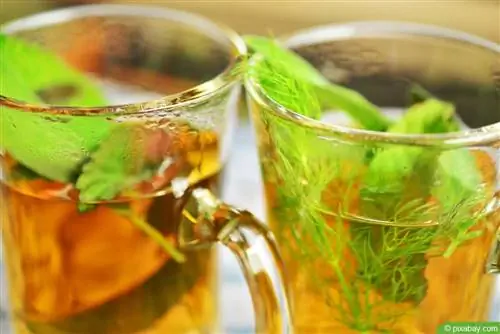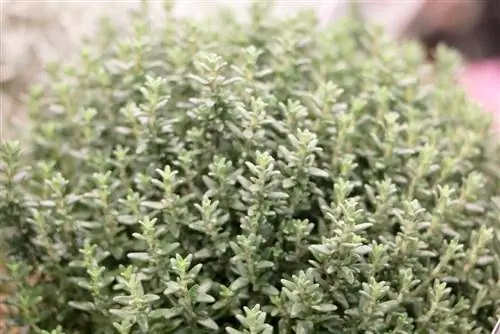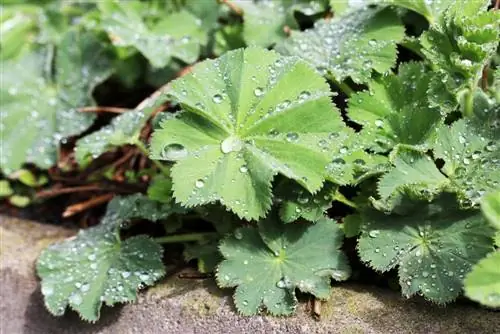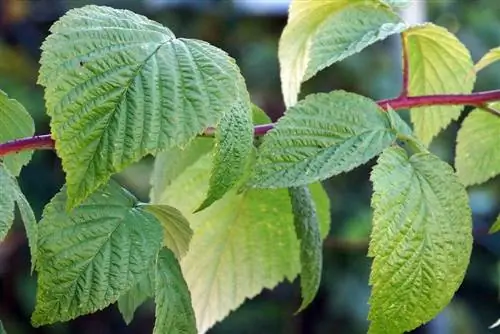- Author admin [email protected].
- Public 2023-12-17 03:39.
- Last modified 2025-01-24 12:45.
Mistletoe has been used for some time to prepare healing teas and tinctures. Since they grow wild between the trees in our local latitudes, the plants can be collected and prepared with appropriate prior knowledge. However, the medicinal plant also has poisonous properties, so caution is advised when making mistletoe tea. In addition, certain aspects must be taken into account when drying so that this process is successful.
Recognize
Mistletoe is an evergreen plant that grows as a parasite in the crowns of deciduous trees and conifers. However, mistletoes are only semi-parasites, as the plants carry out photosynthesis on their own and only use the host's water for their own purposes. In addition, the mistletoe does not destroy its host trees, it just makes itself at home there. Due to the height of many trees, this plant is not easy to find. The best way to locate mistletoe is when the leaves have already fallen from the trees in autumn. Then the mistletoe can be traced in the form of a rounded nest in the treetops. Under no circumstances should entire branches be sawed off to get to the hidden nests; this rough behavior is frowned upon for ecological reasons.
- Lives at the top of trees, especially fruit trees and poplars
- Mistletoe bush grows to about one meter high and wide
- Mistletoe branches form yellowish-green leaves
- The light green branches form a ball
- Flowers are also yellowish-green, relatively inconspicuous and smell slightly of orange
- Flowering time is from March to April
- Waxy and whitish berries form from autumn onwards
- Berries fully ripen in December
Collecting
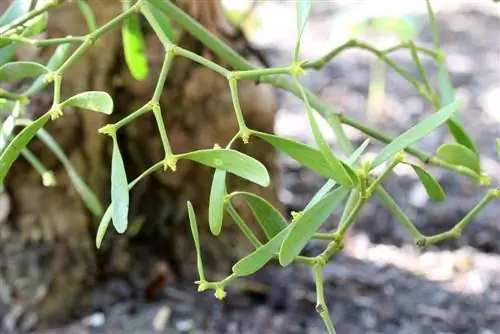
Mistletoe can be collected in the local areas without any problems, as it is not protected by law. However, picking is only permitted for private purposes. Anyone who wants to collect medicinal plants on a large scale for commercial purposes needs prior official approval. To protect the plant and its host tree, a careful approach is very important. The aroma of the medicinal herbs is lowest on rainy days and in the evening and night, so these times should be avoided for harvesting. Since mistletoe berries are highly poisonous, the leaves and twigs should not be collected while they are ripening. Otherwise, accidentally preparing mistletoe tea with berries in it can lead to symptoms of poisoning.
- Mistletoe grows very slowly and can get very old
- Therefore only pick in small quantities
- Always only take a few branches, then the plant will grow back again
- Do not damage the host tree under any circumstances
- A sharp ceramic knife is ideal for cutting
- Put in a soft cloth for transport
- Only the young branches with leaves are used in natural medicine
- The optimal period for collecting is between autumn and spring
- Best harvested in March and April
- Ideally pick early in the morning to late morning
- If possible, do not wash
- Remove coarse dirt with a kitchen towel
- Dry the branches gently and only then cut them to size
Tip:
It is best to collect the medicinal herbs on a rain-free morning, when they have seen a lot of sunlight for at least one or two days before the harvest day.
Drying
This medicinal plant needs gentle drying so that the leaves do not fall off the dried mistletoe. If the plants are brought directly into warm living rooms, the leaves and branches dry out very quickly and then fall off. The reason for this is that the conductive pathways in the stems die off too quickly. If the leaves suddenly stop receiving water, they dry out. This is followed by a yellow and then a brown discoloration, after which the leaves simply fall off. During gentle drying, the plant parts gradually lose the water reserves they contain.
- After cutting, dry in the fresh air for a few days
- Hang cut mistletoe upside down outside
- Tie together into a bouquet first
- Protect dry bouquets from moisture and rain
- Covered terraces and balconies are ideal for drying
- Then bring it into the house and store it safely from moisture
Properties & Healing Effects
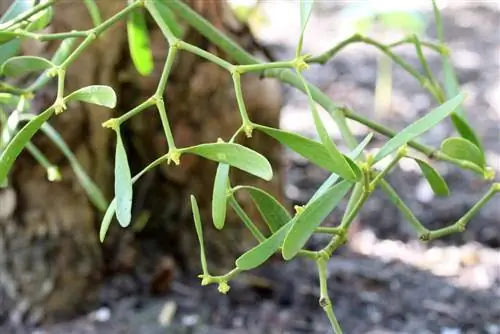
Mistletoe has been used as a medicinal plant in folk medicine for many thousands of years and is considered a panacea. Nowadays, their healing effects have been scientifically proven and proven by many healing successes. Mistletoe contains many pharmaceutically active ingredients, including alkaloids, asparagine, bitter substances, resins, histamines, lecitins and viscotoxins. Mistletoe also contains minerals and secondary plant substances, including flavonoids, which have antioxidant properties.
- Regulates blood pressure and reduces dizziness
- Helps with arteriosclerosis and tinnitus
- Reduces the symptoms of epilepsy
- Relieves asthma, hay fever and whooping cough
- Helps with feelings of anxiety and nervousness
- Improves mental and physical fatigue
- Strengthens the immune system, helpful for diabetes
- Relieves symptoms of respiratory diseases
- Stimulates metabolism
- Helps with menstrual problems and period pain
- Reduces symptoms during menopause
Making tea
In order to enjoy the healing properties of mistletoe, they are usually prepared as tea. After the mistletoe has been sufficiently dried, it is ready for preparation. However, mistletoe has slightly toxic ingredients, which is why this medicinal plant must not be cooked. Otherwise the poisons contained in it will dissolve in the hot water. In addition, heating reduces the healing effects of mistletoe. If you would like to drink mistletoe tea regularly for he alth reasons, you should discuss this with your family doctor. Like any other medicinal plant, mistletoe can cause various side effects that can have a negative effect on existing he alth problems. Some people can also react allergically to the ingredients in mistletoe, so caution is recommended in this case.
- Always prepare mistletoe tea cold
- Carefully chop or cut mistletoe
- Add 1-2 teaspoons of dried mistletoe to 250 ml of cold water
- Let the mixture sit in the cold overnight, about 12 hours
- Then strain well, there should be no residue left
- Warm slightly before enjoying
- The brew is not allowed to boil
- Drink 1-2 cups of mistletoe tea every day
- Infusion made from mistletoe tea can be mixed well with other types of tea
- These include marjoram, marigold, horsetail and willow bark

